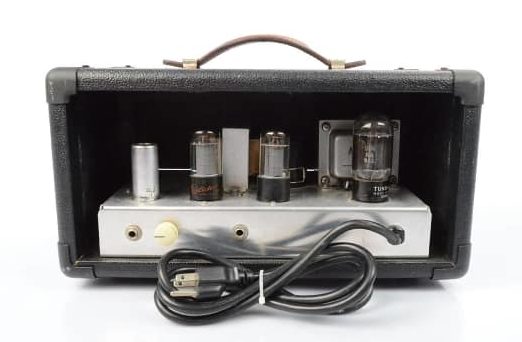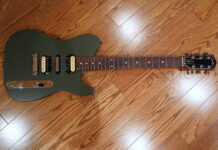
Hi Everybody! Taking time for some guitar gear maintenance will help make your next show or session even better than you planned. From amps, to cables, to pedals, you can prepare in advance so all that’s left for you to do is play music!
CARING FOR YOUR AMP
Amplifiers are mainly used with electric guitars. Often enough, acoustic guitars are played through an amp too. There are two main types of amplifier — Tube amps and Solid State amps. Here are some tips for caring for both kinds.
TUBE AMPS
Change Those Tubes
Tube amps are beautiful creatures. Take this Fender Blues Junior, for example. Great tone, nice warm sound. However beautiful, tube amps can be temperamental at times. A tube is essentially a light bulb. In theory, they can burn out at any time — although they are generally more robust than an old-fashioned light bulb.
Power Tubes

Luckily, problems are often easy to spot, and therefore easy to prevent. For example, if your tube amp seems to have lost a lot of it’s “oomph”, there’s a good chance the power tube needs to be changed. As a part of regular maintenance you can replace your power tubes every 6-12 months. It may help you avoid problems in the first place. Always replace your tubes with the best-quality tubes you can afford, and be sure to replace them with the same kind or model you were using before.
Pre-Amp Tubes
Some amps have a tube pre-amp built in as well. A very common preamp tube is the 12AX7. These could also “burn out” at any time, but usually last much much longer than a power tube. Pre-amp tubes are fairly easy to find because they’re so widely used.
Don’t Fear the Technician
You might want to change the tubes yourself. Usually it’s not too complicated a project. However, NEVER hesitate to contact a technician to do the work for you. It’s often worth the time and money. A good technician is an important part of any guitar gear maintenance regime.
If you do decide to change the tubes yourself, read on!
Out with Old, In with New
Changing tubes is a fairly straightforward project. First, make sure the amp is UNPLUGGED. Second, let the amp sit for a few minutes so that the tubes will cool down. You don’t want to burn your hand; you need it for playing guitar! Once they’re cool, it’s usually easy to pull out the tube, then replace it with the new one. It’s really that simple.
Be as gentle as you can when removing and inserting tubes. It is possible to damage the tube sockets which is a sensitive area.
Scratches and Fizzles
Your tube amp may be giving you some signs of wear that aren’t directly tube related. If you’re hearing scratching sounds, or “fizzles”, it might be the tube sockets that need some cleaning. The metal contacts between the tube and the socket can become oxidized. The result is a less-than-perfect connection between the two. You can hear this imperfection through the amp.
Using electrical contact cleaner (one that is safe for plastic), put a little bit on the pins of the tube. Next, insert the tube into the socket. Remove, then re-insert. Do this a few times and it should give both the tube and the socket a good cleaning. Remember to be gentle with your work, and to ensure your amp is unplugged!
SOLID STATE AMPS
Tough Customers
Solid state amplifiers are a very popular choice for guitarists as well. They rely on transistors instead of tubes for their sound. Because of this they are more rugged and durable than a tube amp, generally speaking. There is one basic rule for maintaining your solid state amp — keep the dust away as much as possible! This goes a long way when caring for your solid state amp.
Beyond this, following these next tips for general care should help a lot. If there is a more serious issue with the amp, it’s best to see an amp technician.
GENERAL AMP CARE
Cleaning the pots
A source of scratching noises in the amp might be in the volume or tone controls. Spraying some electrical contact cleaner is the most common solution. Once you’ve sprayed the pots, move the knob back and forth to work in the cleaner. Repeat if necessary!
Power Cords
Treat your power cords well. After the gig, wrap them gently back into the amp. And when unplugging, be sure to grab the cable from the end, and not from far away! “Pulling” on the cable to unplug is the surest way to damage it. Solid guitar gear maintenance means being able to power it up when needed!
Dust Cover
Protect your amp. Use the cover that comes with it, or buy yourself one. When doing more rigorous travelling, buy a road case. Thank me later!
CABLES
For all the work you may have done on your amps, all will be for naught if you don’t have a good working 1/4” cable. It’s the connection between your instrument and the amp. Strange as it may seem, everything comes down to that wire working well! Here are a few tips to help you to care for your cables.
Cable Wrapping

Many of us wrap our cables from elbow to hand. Here’s some simple advice: STOP DOING THIS. The best way to warp your guitar cable is by holding the end in one hand, then coiling it clockwise in a 8-10” loop. The cable loves this as it’s very gentle on the wiring. When finished, use a cable wrap to keep the cable organized. You’ll avoid those “spaghetti” messes. I use my cables nearly every day, and I’m very thankful for those cable wraps.
Cable Stress
A small and therefore often overlooked detail is cable stress. Cable stress occurs when we have tension at the point where the cable and the input jack meet. The most common place this happens is on the guitar itself, as the strap often pulls the cable tight. Alleviate this stress by creating a bit of slack. After you’ve plugged into your guitar, just pull 2-3” of cable forward through the strap.
Cable Cleaning
If ever you feel you need to clean the contact surfaces of your cables, a cloth and a bit of rubbing alcohol will do the trick. A quick once-over gets rid of dirt and oils with minimal effort. Should you notice some oxidation or rust, a gentle scrub with some VERY light steel wool (Grade 0000) will do the trick. Be sure to clean with rubbing alcohol after you’re finished your delicate scrubbing with the steel wool.
EFFECTS PEDALS
Effects Pedals are an essential part of today’s guitar setup. You more than likely have one – a tuner – if not more. Here are some tips to help you keep your pedals in top working order.
Protection
Protecting your pedals is the best way to ensure a long pedal life. Pedal boards with a case are a great way to keep your investment secure and organized. Plus, it saves a lot of time to have your pedals already set up for you each time you play!
There are hard cases and soft cases available at Best Buy’s web site. Which one to choose? You’ll have to decide based on your needs. I use a soft case, and it serves me very well.
If you do decide to use a pedal board, there is some simple maintenance required. First, every month or so, detach and re-attach all of the connection cables. A quick in-and-out should do the trick. This little action can help chase away oxidization from the contact surfaces. If anything needs a “deeper” cleaning, you can use rubbing alcohol (see “cables” section) or electrical contact cleaner (see amps section).
Keep Your Original Boxes
Over time, you may find that you change around your pedal setup. Some new pedals come in, old ones get set aside for another day. Keep those boxes from when you first purchased the pedal. It’s the best storage place long-term!
Happy Gear, Happy Times
Use some of these guitar gear maintenance ideas to help you keep your stuff in top shape. I often remind myself that all of these tools are here to serve us — to help us have fun and make great music! A little love and care can help you have years of faithful collaboration with your gear. You’ll also avoid those embarrassing moments when equipment breaks down at the wrong time!
There are many tools to choose from to help you with your guitar gear maintenance. Best Buy’s website has a great selection to get your started. Which tools do you use? Which tools will you use in the future?
Good luck with your guitar gear maintenance!



